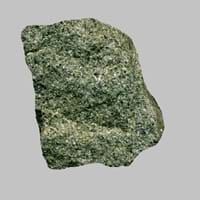Definition
Mylonite is a metamorphic rock formed by ductile deformation during intense shearing encountered during folding and faulting, a process termed cataclastic or dynamic metamorphism
Greywacke is defined as a dark coarse-grained sandstone rock which contains more than 15 per cent clay
Origin
New Zealand
Unknown
Discoverer
Unknown
Unknown
Etymology
From Greek mulōn mill + -ite
From German Grauwacke, from grau grey + wacke
Class
Metamorphic Rocks
Sedimentary Rocks
Sub-Class
Durable Rock, Medium Hardness Rock
Durable Rock, Hard Rock
Group
Not Applicable
Not Applicable
Other Categories
Fine Grained Rock, Opaque Rock
Fine Grained Rock, Opaque Rock
Color
Black to Grey
Beige, Black, Brown, Colourless, Cream, Dark Brown, Green, Grey, Light Green, Light to Dark Grey, Pink, Red, White, Yellow
Durability
Durable
Durable
Scratch Resistant
Yes
Yes
Appearance
Dull, Banded and Foilated
Dull
Interior Uses
Decorative Aggregates, Interior Decoration
Decorative Aggregates, Floor Tiles, Flooring, Homes, Interior Decoration
Exterior Uses
As Building Stone, As Facing Stone, Paving Stone, Garden Decoration
As Building Stone, As Facing Stone, Garden Decoration, Office Buildings, Paving Stone
Other Architectural Uses
Curbing
Curbing, Whetstones
Construction Industry
for Road Aggregate, Landscaping, Roadstone
Building houses or walls, Cement Manufacture, Construction Aggregate, for Road Aggregate, Raw material for the manufacture of mortar
Medical Industry
Not Yet Used
Not Yet Used
Antiquity Uses
Artifacts, Monuments
Artifacts, Sculpture, Small Figurines
Commercial Uses
Creating Artwork, Gemstone, Jewelry
As armour rock for sea walls, Petroleum reservoirs, Sea Defence, Tombstones
Types
Blastomylonites, Ultramylonites and Phyllonites
Not Available
Features
Surfaces are often shiny
Available in Lots of Colors and Patterns, Generally rough to touch, Non-vesicular, Veined
Archaeological Significance
Monuments
Used
Not Yet Used
Famous Monuments
Data Not Available
Not Applicable
Famous Sculptures
Data Not Available
Data Not Available
Pictographs
Used
Not Used
Petroglyphs
Used
Not Used
Formation
Mylonites are ductilely deformed rocks formed by the accumulation of large shear strain, in ductile fault zones.
Graywacke rock is a type of sedimentary rock, which is also known as immature sandstone, which is indurated, dark grey and consisting of poorly sorted angular to sub-angular, sand-sized grains.
Mineral Content
Porphyroblasts
Augite, Biotite, Calcite, Chlorite, Clay, Clay Minerals, Feldspar, Micas, Muscovite or Illite, Plagioclase, Pyroxene, Quartz
Compound Content
Aluminium Oxide, Calcium Sulfate, Chromium(III) Oxide, Iron(III) Oxide, Magnesium Carbonate, Silicon Dioxide
Aluminium Oxide, NaCl, CaO, Chromium(III) Oxide, Iron(III) Oxide, FeO, Potassium Oxide, Magnesium Carbonate, MgO, MnO, Sodium Oxide, Phosphorus Pentoxide, Silicon Dioxide, Titanium Dioxide
Types of Metamorphism
Not Applicable
Not Applicable
Types of Weathering
Biological Weathering, Chemical Weathering, Mechanical Weathering
Biological Weathering, Chemical Weathering
Types of Erosion
Chemical Erosion, Sea Erosion, Wind Erosion
Coastal Erosion, Sea Erosion, Wind Erosion
Grain Size
Fine Grained
Angular and Fine
Fracture
Conchoidal
Conchoidal
Porosity
Highly Porous
Highly Porous
Compressive Strength
Not Available
Cleavage
Conchoidal
Perfect
Toughness
Not Available
2.6
Specific Gravity
2.97-3.05
2.2-2.8
Transparency
Opaque
Opaque
Density
2.6-4.8 g/cm3
2.6-2.61 g/cm3
Specific Heat Capacity
Not Available
Resistance
Heat Resistant, Impact Resistant, Pressure Resistant
Heat Resistant, Impact Resistant, Pressure Resistant
Deposits in Eastern Continents
Asia
China, India, Indonesia, Saudi Arabia, South Korea
China, India, Kazakhstan, Mongolia, Russia, Uzbekistan
Africa
Eritrea, Ethiopia, Ghana, South Africa, Western Africa
Namibia, Nigeria, South Africa
Europe
England, Finland, France, Germany, Great Britain, Greece, United Kingdom
Austria, Denmark, Germany, Great Britain, Netherlands, Norway, Poland, Sweden, Switzerland, United Kingdom
Others
Not Yet Found
Greenland
Deposits in Western Continents
North America
USA
Canada, USA
South America
Not Yet Found
Brazil
Deposits in Oceania Continent
Australia
Central Australia, Western Australia
New South Wales, New Zealand
All about Mylonite and Greywacke Properties
Know all about Mylonite and Greywacke properties here. All properties of rocks are important as they define the type of rock and its application. Mylonite belongs to Metamorphic Rocks while Greywacke belongs to Sedimentary Rocks.Texture of Mylonite is Foliated whereas that of Greywacke is Clastic. Mylonite appears Dull, Banded and Foilated and Greywacke appears Dull. The luster of Mylonite is shiny while that of Greywacke is dull. Mylonite is available in black to grey colors whereas Greywacke is available in beige, black, brown, colourless, cream, dark brown, green, grey, light green, light to dark grey, pink, red, white, yellow colors. The commercial uses of Mylonite are creating artwork, gemstone, jewelry and that of Greywacke are as armour rock for sea walls, petroleum reservoirs, sea defence, tombstones.










